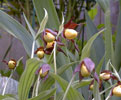|
|
|
|
|
| |
Flasks of
Cypripedium parviflorum var. parviflorum 'MC823' -spontaneous |
|
| |
|
|
| |
|
|
Click to Enlarge

Pod Parent Flowers |
|
|
|
| |
For additional origin/habitat information supplied courtesy of
Charles and Margaret Baker, see further below, near the bottom of this page.
|
Temperatures we attempt to use in the lab & greenhouse:
| For Infraspecies: |
|
Spring, Summer, Autumn: days average 80°F, nights 61°F; best fit is Intermediate 83-60°F
(Source:
Baker's Web OSC) |
| For Infraspecies: |
|
Winter: days average 25°F, nights 9°F; best fit is Frigid 46-28°F
(Source:
Baker's Web OSC) |
|
About the name...
| Etymology of |
Cypripedium |
|
From Greek "Kypris" Aphrodite; "pedilon" shoe.
(Source:
Pridgeon 1992) |
| Etymology of |
parviflorum |
|
From Latin "parviflorus" small-flowered.
(Source:
Mayr & Schmucker 1998) |
| Pronunciation of |
Cypripedium |
|
sip-re-PEE-dee-um
(Source:
Pridgeon 1992) |
| Pronunciation of |
parviflorum |
|
par-vi-FLOE-rum
(Source:
Hawkes 1978) |
|
If you would like to direct someone to this web page, please copy and paste this URL into your email:
http://troymeyers.com/d?012672
| Flask Information |
| Availability: |
We have sold all of the flasks for this item. |
| You should: |
Consider getting individual plants or compots instead of a flask.
You can place a "Notify Flask Recipients" Request, and either we or a flask recipient may contact you when plants are available.
You may also place a "Notify Retries" Request, and if an identical pollination (the same parents) is done again, we'll let you know.
You may reserve a flask, but it's very unlikely you'll get one ...this could only happen if we found a flask that we didn't know we had. |
| Yield Estimate: |
3 plants (based on flask surveys done 11/18/2002 )
|
| Plantlet Sizes: |
From many flasks 15 - 20 mm plants (based on flask surveys done 02/13/2003 )
From one most recently surveyed flask 15 - 20 mm (02/13/2003)
|
|
You might also want to:
|
View the seed assay for this item.
View items of the same species.
View items of the same genus.
|
| Ordering Information |
| You are not currently logged in. |
|
You must be a registered user and be logged in to reserve a flask or place a notification request. Please log in:
|
|
|
|
|
|
| |
The origin/habitat information below is supplied courtesy of Charles and Margaret Baker
The following information is based on the name of the plant provided by the donor, and assumes that the name is correct. If the plant has been misidentified, then the following information may not be correct.
This text is copyrighted by the Bakers and may not be reproduced without permission.
ORIGIN/HABITAT: Widespread across much of North America. Distribution
extends from extreme eastern Alaska along the border with the Yukon
Territories of western Canada with the northern limit arcing southeastward
across Canada to Quebec and Newfoundland. Distribution extends southward
into southeast Alaska and then southward through British Colombia, with a
finger of habitat extending into eastern Washington and Oregon and
northern Idaho in the Pacific Northwest. The southern boundary of
distribution then follows fairly closely along the U. S. Canadian border
to North Dakota where it moves abruptly southward into Texas and Louisiana
where it then curves northeastward through the southern and eastern states
and the eastern provinces of Canada to Newfoundland. There is an isolated
area of habitat in Arizona, New Mexico, and Colorado. Plants are found in
woods where they grow in partial shade in well drained but heavy, damp,
humus-rich soils. They may also be found on rocky hillsides, along
streams, in meadows and clearings, in shallow depressions in peaty soil on
treeless limestone barrens, and in talus of limestone cliffs. Plants seem
to thrive in limestone areas, but the soils usually are neutral to
slightly acidic. Habitat elevation throughout the range varies from near
sea level to as high as 6550 ft. (2000 m).
More about this information and the Bakers...
|
|
|
| |
|
|
|